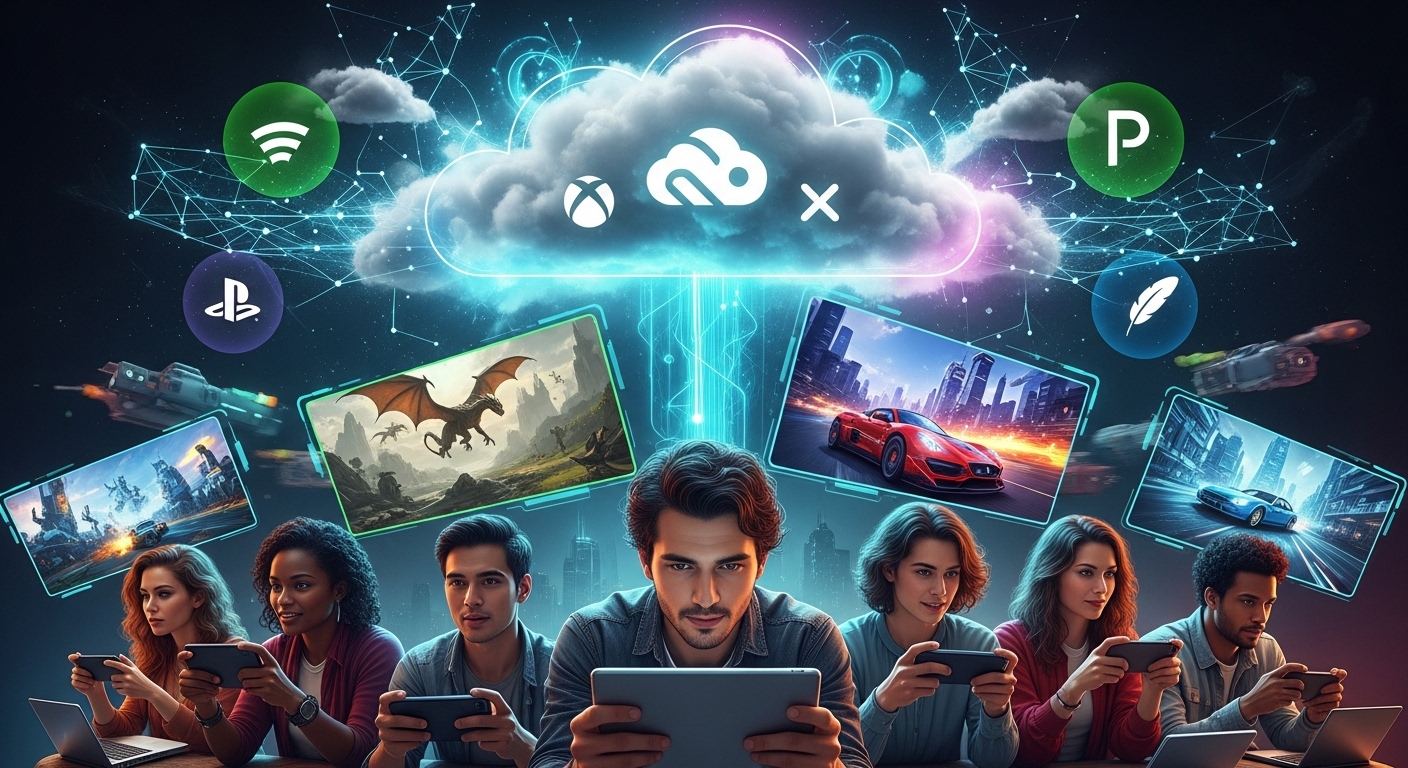
The Growing Influence of Cloud Gaming: A Revolution in the Gaming Industry
The gaming industry is no stranger to innovation, with each decade bringing transformative technologies that reshape how games are developed and played. In recent years, cloud gaming has emerged as one of the most disruptive forces, challenging traditional paradigms and opening up new possibilities for gamers and developers alike. This revolution not only changes how games are accessed but also impacts the underlying infrastructure and business models of the gaming world.
The Evolution of Cloud Gaming
Cloud gaming, also known as gaming on demand or game streaming, is a technology that allows users to play games via the internet without the need for powerful hardware. This concept isn’t entirely new; its roots can be traced back to the early 2000s when companies began exploring ways to deliver high-end gaming experiences remotely. However, it wasn’t until the last decade that technological advancements in internet speed, cloud computing, and data centers made cloud gaming a viable and attractive proposition for the mainstream audience.
Today, several leading companies such as NVIDIA with GeForce Now, Google with Stadia, and Microsoft with Xbox Cloud Gaming are pioneering the cloud gaming space, offering a wide range of services that cater to different segments of the gaming population. These platforms have made it possible for gamers to enjoy high-definition and graphically intensive games on low-end devices like smartphones and Chromebooks.
Advantages of Cloud Gaming

The shift towards cloud gaming brings numerous benefits that extend beyond mere convenience. One of the most significant advantages is the elimination of the need for expensive hardware. With cloud gaming, the processing power is handled by remote servers, meaning gamers no longer need the latest consoles or gaming PCs to enjoy new releases. This democratization of gaming hardware has the potential to expand the gaming audience significantly, making high-quality games accessible to those who may not have been able to afford them otherwise.
Moreover, cloud gaming offers unparalleled flexibility and convenience. Gamers can play their favorite titles on a variety of devices, switching seamlessly between a TV, laptop, or smartphone without losing their progress. This flexibility aligns with modern consumer expectations for cross-platform compatibility and uninterrupted experiences. Additionally, updates and patches are handled server-side, ensuring that players always have the latest version of a game without lengthy downloads or installations.
Challenges Facing Cloud Gaming
Despite the promising prospects, cloud gaming faces several hurdles that need to be addressed to realize its full potential. One of the most pressing challenges is the reliance on high-speed internet connections. While urban areas in developed countries may enjoy robust internet infrastructure, many regions still grapple with connectivity issues that can hinder the quality of cloud gaming experiences.
Latency is another critical concern. The time it takes for a player’s input to register on the server and reflect in the game can significantly impact gameplay, particularly in fast-paced genres such as first-person shooters or competitive multiplayer games. Advances in edge computing and 5G technology promise to mitigate these latency issues, but widespread implementation is still on the horizon.
The Impact on Game Development and Distribution
Cloud gaming is also reshaping the landscape for game developers and distributors. By offloading processing power to the cloud, developers can focus on creating richer, more immersive experiences without being constrained by the limitations of consumer hardware. This shift could lead to a new era of gaming innovation, with developers pushing the boundaries of what’s possible in terms of graphics, physics, and artificial intelligence.

From a distribution perspective, cloud gaming allows for a more streamlined approach. Games can be released globally without the need for physical copies, reducing manufacturing and logistics costs. This digital-first approach aligns with the broader trends in media consumption and offers a more sustainable model by reducing the environmental impact associated with physical media.
Business Models and Economic Implications
The economic implications of cloud gaming extend across the entire gaming ecosystem. Subscription-based models, similar to those seen in video streaming services, are becoming increasingly popular. This model provides steady revenue streams for companies while allowing gamers access to vast libraries of games for a monthly fee. Services like Xbox Game Pass and PlayStation Now are examples of this trend, offering gamers flexibility and variety at a lower cost than purchasing individual titles.
Additionally, cloud gaming opens up new opportunities for monetization through in-game purchases and microtransactions. With easier access to games, developers have more touchpoints to engage with players and offer value-added services. However, this also raises concerns about consumer spending and the potential for exploitation through aggressive monetization strategies.
The Future of Cloud Gaming
As technology continues to evolve, the future of cloud gaming looks promising. The convergence of cloud gaming with other emerging technologies like virtual reality (VR) and augmented reality (AR) could unlock new gaming experiences that were previously unimaginable. Imagine a world where players can stream VR games directly to a headset without being tethered to a powerful PC.

Moreover, the integration of artificial intelligence in cloud gaming platforms could enhance personalization, offering tailored recommendations and adaptive gameplay experiences that respond to individual player preferences and skills.
Takeaways
The growing influence of cloud gaming is undeniably a revolution in the gaming industry. It challenges traditional norms, democratizes access, and paves the way for innovative business models and game development practices. While challenges remain, the potential benefits for gamers, developers, and the industry as a whole are immense.
As infrastructure improves and technology advances, cloud gaming is set to become a dominant force, reshaping how we think about gaming and entertainment in the digital age. Stakeholders across the industry must adapt to these changes and embrace the opportunities cloud gaming presents, ensuring that the future of gaming is inclusive, innovative, and exciting.
Cloud Gaming and the Global Gaming Community
One of the remarkable impacts of cloud gaming is its ability to foster a truly global gaming community. By removing the barriers of expensive hardware and broadening accessibility, cloud gaming allows players from diverse backgrounds and regions to connect and compete on a level playing field. This inclusivity can lead to a richer and more vibrant gaming ecosystem, where ideas and cultures intermingle to create unique gaming experiences.
With cloud gaming, the potential for global tournaments and esports events is greatly enhanced. Players can participate from virtually anywhere in the world, provided they have a stable internet connection. This global reach not only increases participation but also broadens the audience, turning gaming into a more universally shared experience. Platforms like Twitch and YouTube Gaming are already capitalizing on this trend, providing gamers with platforms to showcase their skills and connect with fans worldwide.
The Role of Partnerships and Collaborations

The expansion of cloud gaming has also seen a rise in strategic partnerships and collaborations. Tech giants, game developers, and telecom companies are joining forces to advance the capabilities and reach of cloud gaming services. For instance, partnerships between cloud service providers and game developers can result in optimized game performance and exclusive content, giving consumers more reasons to adopt cloud gaming platforms.
Telecom companies are also crucial players in this ecosystem, as they provide the necessary infrastructure for high-speed internet that cloud gaming relies upon. As 5G networks roll out globally, these collaborations will likely intensify, with telecom companies bundling cloud gaming services with their offerings to attract new customers.
The Environmental Impact of Cloud Gaming
While cloud gaming offers many advantages, it’s important to consider its environmental impact. The data centers that power cloud gaming consume significant amounts of energy and require efficient cooling systems to operate. However, many companies are aware of these challenges and are actively working towards sustainable solutions. For example, some cloud service providers are investing in renewable energy sources to power their data centers, reducing their carbon footprint.
Moreover, the shift towards digital distribution can reduce the environmental impact associated with the production and disposal of physical game media. By embracing digital solutions and prioritizing sustainability, the gaming industry can continue to innovate while minimizing its ecological impact.
Consumer Adoption and Market Trends
Consumer adoption of cloud gaming is steadily increasing, driven by the convenience and accessibility it offers. Market trends indicate that younger generations, who are accustomed to streaming services, are more likely to embrace cloud gaming. The flexibility to play anytime, anywhere, coupled with a growing library of games, makes cloud gaming an attractive option for digital natives.

Additionally, as more exclusive titles and features are developed for cloud platforms, consumer interest is expected to rise. The ability to access a game library with diverse offerings without a hefty upfront investment appeals to casual gamers and hardcore enthusiasts alike. As customer preferences evolve, companies will need to continue innovating to capture and retain their audience.
Overcoming Security and Privacy Concerns
As with any digital service, cloud gaming raises concerns about data security and privacy. Players are required to create accounts, often linking personal information and payment details to access games. Ensuring robust security measures to protect this data is paramount for cloud gaming providers.
Companies are investing in advanced encryption technologies and multi-factor authentication to safeguard user data. Educating consumers about safe online practices and transparent privacy policies can also help build trust and confidence in cloud gaming services.
Final Thoughts on Cloud Gaming’s Future
Cloud gaming represents a significant paradigm shift in the gaming industry, offering exciting possibilities for both players and developers. While there are challenges to overcome, the potential for innovation and global connectivity is immense. As technology continues to evolve and infrastructure improves, cloud gaming is poised to become a staple in the gaming landscape.
Embracing this revolution requires collaboration across the industry, from developers and tech companies to telecom providers and regulators. Together, they can create an environment where cloud gaming thrives, delivering immersive experiences to gamers worldwide while addressing the challenges head-on.
The journey ahead is promising, and as cloud gaming continues to grow, it will undoubtedly shape the future of digital entertainment, redefining how we play, connect, and experience games.







